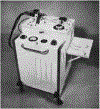Ultraviolet Irradiation of Blood: "The Cure That Time Forgot"?
- PMID: 29124710
- PMCID: PMC6122858
- DOI: 10.1007/978-3-319-56017-5_25
Ultraviolet Irradiation of Blood: "The Cure That Time Forgot"?
Abstract
Ultraviolet blood irradiation (UBI) was extensively used in the 1940s and 1950s to treat many diseases including septicemia, pneumonia, tuberculosis, arthritis, asthma and even poliomyelitis. The early studies were carried out by several physicians in USA and published in the American Journal of Surgery. However with the development of antibiotics, UBI use declined and it has now been called "the cure that time forgot". Later studies were mostly performed by Russian workers and in other Eastern countries and the modern view in Western countries is that UBI remains highly controversial.This chapter discusses the potential of UBI as an alternative approach to current methods used to treat infections, as an immune-modulating therapy and as a method for normalizing blood parameters. No resistance of microorganisms to UV irradiation has been reported, and multi-antibiotic resistant strains are as susceptible as their wild-type counterparts. Low and mild doses of UV kill microorganisms by damaging the DNA, while any DNA damage in host cells can be rapidly repaired by DNA repair enzymes. However the use of UBI to treat septicemia cannot be solely due to UV-mediated killing of bacteria in the blood-stream, as only 5-7% of blood volume needs to be treated with UV to produce the optimum benefit. UBI may enhance the phagocytic capacity of various phagocytic cells (neutrophils and dendritic cells), inhibit lymphocytes, and oxidize blood lipids. The oxidative nature of UBI may have mechanisms in common with ozone therapy and other oxygen therapies. There may be some similarities to extracorporeal photopheresis (ECP) using psoralens and UVA irradiation. However there are differences between UBI and ECP in that UBI tends to stimulate the immune system, while ECP tends to be immunosuppressive. With the recent emergence of bacteria that are resistant to all known antibiotics, UBI should be more investigated as an alternative approach to infections, and as an immune-modulating therapy.
Keywords: Antigen-presenting cells; Blood cells; Cytokines; DNA repair; Infections; Knott hemo-irradiator; UBI; Ultraviolet C.
Figures
Similar articles
-
Ultraviolet blood irradiation: Is it time to remember "the cure that time forgot"?J Photochem Photobiol B. 2016 Apr;157:89-96. doi: 10.1016/j.jphotobiol.2016.02.007. Epub 2016 Feb 5. J Photochem Photobiol B. 2016. PMID: 26894849 Free PMC article. Review.
-
Use of Ultraviolet Blood Irradiation Against Viral Infections.Clin Rev Allergy Immunol. 2021 Apr;60(2):259-270. doi: 10.1007/s12016-020-08811-8. Epub 2020 Oct 7. Clin Rev Allergy Immunol. 2021. PMID: 33026601 Free PMC article. Review.
-
Ultraviolet C irradiation: an alternative antimicrobial approach to localized infections?Expert Rev Anti Infect Ther. 2012 Feb;10(2):185-95. doi: 10.1586/eri.11.166. Expert Rev Anti Infect Ther. 2012. PMID: 22339192 Free PMC article. Review.
-
A simplified extracorporeal photopheresis procedure based on single high-dose ultraviolet A light irradiation shows similar in vitro efficacy.Transfusion. 2021 Mar;61(3):883-893. doi: 10.1111/trf.16209. Epub 2020 Dec 10. Transfusion. 2021. PMID: 33300629
-
Ultraviolet A light effectively reduces bacteria and viruses including coronavirus.PLoS One. 2020 Jul 16;15(7):e0236199. doi: 10.1371/journal.pone.0236199. eCollection 2020. PLoS One. 2020. PMID: 32673355 Free PMC article.
Cited by
-
Potential treatments of COVID-19: Drug repurposing and therapeutic interventions.J Pharmacol Sci. 2023 May;152(1):1-21. doi: 10.1016/j.jphs.2023.02.004. Epub 2023 Feb 15. J Pharmacol Sci. 2023. PMID: 37059487 Free PMC article. Review.
-
"Photobiomics": Can Light, Including Photobiomodulation, Alter the Microbiome?Photobiomodul Photomed Laser Surg. 2019 Nov;37(11):681-693. doi: 10.1089/photob.2019.4628. Epub 2019 Oct 9. Photobiomodul Photomed Laser Surg. 2019. PMID: 31596658 Free PMC article. Review.
-
Should we use extracorporeal photopheresis more often? Evidence from graft-versus-host disease patients monitored with Treg as a biomarker.Future Sci OA. 2020 Aug 10;6(8):FSO623. doi: 10.2144/fsoa-2020-0107. Future Sci OA. 2020. PMID: 32983569 Free PMC article.
-
Photodynamic therapy in oral lichen planus: A prospective case-controlled pilot study.Sci Rep. 2020 Feb 3;10(1):1667. doi: 10.1038/s41598-020-58548-9. Sci Rep. 2020. PMID: 32015380 Free PMC article.
-
COVID-19 and the ethnicity link - is there a photochemical link?Photochem Photobiol Sci. 2021 Jan;20(1):183-188. doi: 10.1007/s43630-020-00004-8. Epub 2021 Jan 8. Photochem Photobiol Sci. 2021. PMID: 33721239 Free PMC article.
References
-
- Frercksa J, Weberb H, Wiesenfeldt G (2009) Reception and discovery: the nature of Johann Wilhelm Ritter’s invisible rays. Stud Hist Philos Sci Part A 40:143–156
-
- Bonnet A (1845) Traite des Maladies des Articulations. Bailliere, Paris
-
- Barth J, Kohler U (1992) Photodermatologie in Dresden-ein historischer Abriss Festschrift anlasslich des 75. Geburtstages von Prof. Dr. Dr. Dr. h.c. H.-E. Kleine-Natrop (1917–1985). Dresden
-
- Downes A, Blunt TP (1877) Researches on the effect of light upon bacteria and other organisms. Proc R Soc Lond 26:488–500
-
- Finsen NR (1901) Phototherapy. Edward Arnold, London
Publication types
MeSH terms
Substances
Grants and funding
LinkOut - more resources
Full Text Sources
Other Literature Sources
Medical





